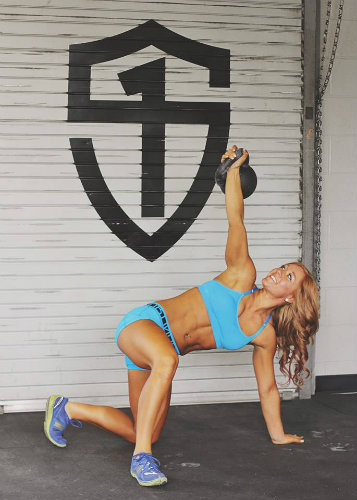Attention CrossFitters: Do you want to be a supple leopard? Do you want a resilient body to avoid injuries and PR across the board? What if I told you that there was an exercise that you could do before your workouts that won’t burn you out and would promote great mobility and stability? All too often I see athletes warming up for their WODs with foam rollers, lacrosse balls or pretty much anything that looks like it’s from the middle ages to relax muscles and gain mobility. Stop “smashing” so much and add this exercise to your warm up.
SIDE NOTE – Give yourself at least 10-15 minutes before a WOD to warm your muscles up with mobility and stability exercises. I learned at an early age from my father to be early. I was taught a saying “If you’re early, you’re on time. If you’re on time, you’re late. If you’re late, it’s unacceptable.” I understand that it’s hard to always be early, but if you want to have a body like a leopard, you need to MAKE time for mobility and stability drills.
Enter the Turkish Get-Up
Before the Get-Up is introduced, let’s revisit our youth. When you are a newborn, you don’t know how to crawl, walk or run. These are learned in a particular sequence called postural ontogenesis which is genetically programmed into humans. These are also learned by trial and error. When one movement pattern does not succeed you dust yourself off and try again. Your body learns by failing and trying again. Rome wasn’t built in a day and neither were you. This is the process of developmental kinesiology and it’s done automatically. These are some of the principles and stages taught in Dynamic Neuromuscular Stabilization (DNS) by Pavel Kolar, PaeDr, PhD.
- 6 weeks old – you just learned to lift your head.
- 3 1/2 months – you’re able to bring your knees up, create Intra-abdominal Pressure (IAP) and have proper breathing mechanics.
- 4 1/2 months – you’re now able to create midline (sagittal) stability, which creates “functional joint centration.” This allows the ability to use your extremities.
- 6 months – your abdominal chains are starting to be developed, which allows you to get onto your side. Coordination between your pelvic, back and core muscles is established.
- 6-9 months – you now have the ability to go into an oblique sitting position (tri-pod position) and eventually a seated position. Also, during this time you are to develop your contralateral patterns, AKA crawling. Towards the end of these months you are able to slowly stand up with the support of a stationary object (or your parents help).
- 10-12 months – you’re now able to get into a deep squatting position (you were so much better back then!). Eventually, with trial and error, and a whole lot of butt soreness, you will find a way to walk.
Recap. You were a newborn and barely could move, then you learned how to move your arms and legs, then support yourself and eventually ended up standing up.
Enter the Get-Up
Now let’s return to present day you. It is time to introduce (or get re-acquainted) with the Turkish Get-Up. The progressions you went through when you were a baby are very similar to the progressions of a Turkish Get-Up. You go from your back to a standing position with weight.
I can’t emphasize how amazing of an exercise this is when performed properly. It is the ultimate for mobility and stability. This exercise is so powerful that Gray Cook, the founder of the Functional Movement Systems, considered using the Turkish Get-Up alone as a movement screen to find asymmetries or weaknesses because of it’s all around functional use.
Emphasis is placed on the form and smoothness between transitions. If you have great form it creates perfect “centration” of your joints, which places compression in the perfect amount to each joint involved. The reason the Get-Up is so great is because it helps centrate almost all the joints in your body. Thus, creating great mobility and stability in each region of the body leaving you a less “smashed” mobile CrossFit athlete.
A couple of tips to keep in mind
- Think core first. A relaxed core while under load is asking for trouble.
- Get your shoulders away from your ears in every position
- Don’t neglect a shoulder, meaning don’t slouch with the down arm and down hike the one with weight
- Don’t hyperextend your low back. I see this in the oblique seated position and at the top of the Get-Up. See number 1.
- This is not an exercise you will PR in…
- Slow and steady, stays healthiest the longest. Some call the Get-Up “weighted yoga”
- Have Fun. You may need to trial and error to get it right.
- Have someone familiar with the movement to watch your form.
Watch the video here. Starting at 4:38 for a good example. https://youtu.be/l5qB0nILpko?t=4m38s
So, become a baby for a few minutes before your next WOD. Check back soon to learn about the benefits of crawling, my favorite bodyweight exercise.
Dr. Joshua Thorp
Resources
Dynamic Neuromuscular Stabilization (DNS) Course A and Sport I by Pavel Kolar, PaeDr. PhD.
StrongFirst / Functional Movement Systems Foundational Strength Course by Gray Cook and Brett Jones

